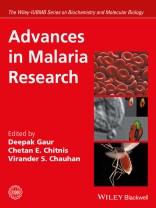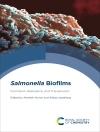Tabella dei contenuti
List of contributors xiii
Foreword xvii
Preface xix
1 Introduction: An overview of malaria and Plasmodium 1
Virander S. Chauhan, Chetan E. Chitnis, and Dee...
Tabella dei contenuti
List of contributors xiii
Foreword xvii
Preface xix
1 Introduction: An overview of malaria and Plasmodium 1
Virander S. Chauhan, Chetan E. Chitnis, and Deepak Gaur
History 1
The life cycle of Plasmodium 3
A significant milestone in malaria research: Adaptation of Plasmodium to laboratory culture 4
The advent of present-day technologies and their applications in malaria research 5
Bibliography 6
2 Exoerythrocytic development of Plasmodium parasites 9
Volker T. Heussler, Annika Rennenberg, and Rebecca R. Stanway
The sporozoite’s journey from the skin to the liver 10
Sporozoite invasion 14
Parasite development 15
Protein export from the parasite into the host cell 20
Parasite egress 23
The role of innate immune responses during merosome formation 26
Acknowledgments 27
Bibliography 27
3 Molecular basis of erythrocyte invasion by Plasmodium merozoites 33
Deepak Gaur, Chetan E. Chitnis, and Virander S. Chauhan
The structure of the merozoite 39
The steps of erythrocyte invasion 41
Redundancy and ligand-receptor interactions that mediate parasite adhesion during erythrocyte invasion 57
Signaling events during erythrocyte invasion by malaria parasites 74
Summary and conclusions 75
Bibliography 75
4 The biology of malaria transmission 87
Robert E. Sinden
Purpose 87
History 87
The current research agenda 88
Biology 88
Population dynamics 106
Transmission-blocking interventions 110
Bibliography 114
5 Comparative and functional genomics of malaria parasites 125
Martine M. Zilversmit, Sittiporn Pattaradilokrat, and Xin-zhuan Su
An Introduction to Plasmodium genomes 125
Genome structure of malaria parasites 127
From genome sequences to gene function 133
Summary 139
Acknowledgments 139
Bibliography 139
6 Gene regulation: New insights and possible intervention strategies 149
Artur Scherf, Nicholas A. Malmquist, Rafael M. Martins, Shruthi S. Vembar, and Jose-Juan Lopez-Rubio
Introduction 149
Modes of gene regulation 150
Drug targeting 164
Perspectives 169
Bibliography 171
7 Molecular genetic approaches to malaria research 179
Brendan Elsworth, Mauro F. Azevedo, Brendan S. Crabb, and Paul R. Gilson
Transfection methods 179
Genetic approaches for deriving gene function 184
Conditional knockdown of protein function 187
Protein reporters 190
Conclusions 192
Bibliography 192
8 Transcriptomics and proteomics 197
Archana P. Gupta, Zbynek Bozdech, and Peter R. Preiser
Transcriptional profiling throughout the parasite life cycle 198
Transcriptional regulation 201
Transcriptional variation 205
Biological insights 208
Proteomics 208
Translational regulation 209
Conclusion 212
Bibliography 212
9 The biochemistry of Plasmodium falciparum: An updated overview 219
Hagai Ginsburg
MPMP 219
Carbohydrates 219
Lipid metabolism 227
Amino acids 240
Nucleotide metabolism 252
Cofactors 256
Redox metabolism 265
Mitochondrial functions 268
Hemoglobin digestion and hemozoin production 273
Some reflections for the future 276
Bibliography 277
10 Signaling in malaria parasites 291
Pushkar Sharma and Sudhir Kumar
Protein phosphorylation in Plasmodium 291
Calcium-mediated signaling in Plasmodium 292
Phosphoinositide signaling and trafficking in malaria parasites 295
Cyclic nucleotide signaling in the malaria parasite 296
Future challenges 300
Bibliography 300
11 Membrane transport proteins as therapeutic targets in malaria 307
Sanjay A. Desai, Kempaiah Rayavara, Paresh Sharma, Sayeed K. Syed, Wang Nguitragool, and Praveen Balabaskaran Nina
Host erythrocyte membrane: A shared ion and nutrient channel 308
Parasitophorous vacuolar membrane: Protein export and solute uptake 311
Parasite plasma membrane: Similar to other eukaryotic cells, but different 314
Digestive vacuole: A specialized lysosome-equivalent in the parasite 316
Mitochondrial inner membrane: An unusual ATP synthase with uncertain function 318
Conclusions 319
Acknowledgments 319
Bibliography 319
12 The proteolytic repertoire of malaria parasites 325
Puran Singh Sijwali and Philip J. Rosenthal
Aspartic proteases 325
Cysteine proteases 330
Metalloproteases 333
Serine proteases 335
Threonine proteases 338
Roles of proteases in parasite development 340
Summary and conclusions 343
Acknowledgments 343
Bibliography 343
13 Development of medicines for the control and elimination of malaria 353
Jeremy N. Burrows and Timothy N. C. Wells
Targets for the development of future medicines for malaria 356
The process of












